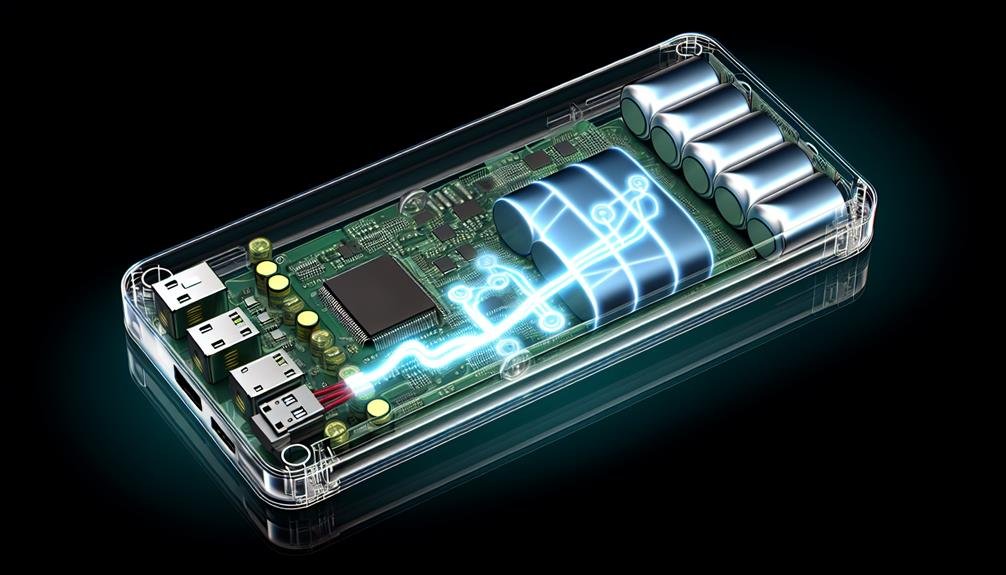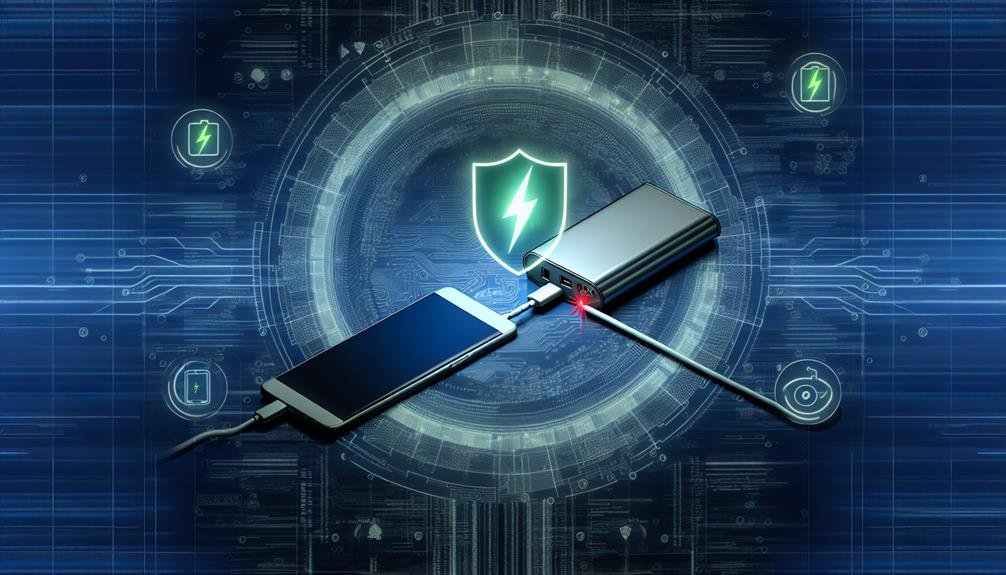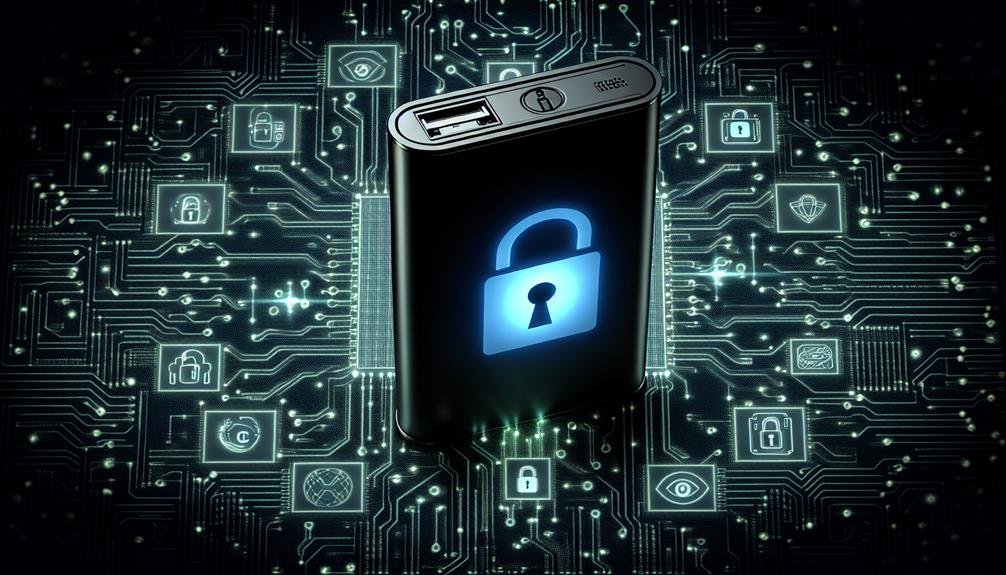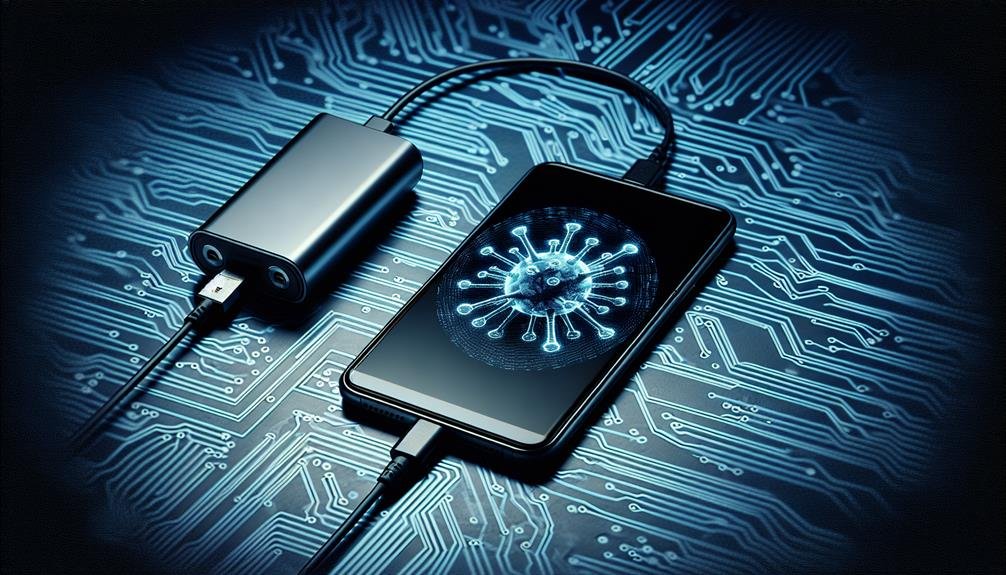Yes, a power bank can potentially have viruses. Power banks store electrical energy and, if they have data transfer capabilities, can also harbor malware. When you connect your device via USB, a compromised power bank could transmit malicious software, leading to data breaches and unauthorized access. Firmware vulnerabilities are another risk, making regular updates essential. To safeguard your devices, use reputable brands and secure charging practices. Understanding these risks and knowing how to protect your tech will help keep your data safe and your devices secure. If you're curious about further precautions and best practices, there's more to explore.
How Power Banks Work

To understand whether a power bank can have viruses, you first need to grasp how power banks work, focusing on their basic functionality and internal components. Fundamentally, power banks are portable devices designed to store electrical energy, which you can later use to charge your mobile devices. They contain rechargeable lithium-ion or lithium-polymer batteries, which dictate the battery capacity, an important factor in how long and how many times you can charge your devices.
When you plug your device into a power bank, you're basically drawing stored electrical energy from the internal battery. The charging speed depends on the power output of the power bank, which is often measured in amperes (A). Higher amperage can charge your devices faster but requires more robust internal circuitry to manage the increased power flow safely.
Inside, power banks also house a microcontroller unit (MCU) that regulates the charging process, ensuring your devices receive the correct amount of power without overloading. This MCU is essential for safety, preventing issues like overheating and overcharging. While it plays a pivotal role in functionality, understanding its presence helps you discern potential vulnerabilities in the context of cybersecurity threats.
Common Cybersecurity Threats
In the domain of cybersecurity, common threats such as malware, phishing, and data breaches pose substantial risks to digital devices and their users. As you navigate through a world increasingly reliant on technology, it's pivotal to develop cybersecurity awareness and implement prevention tactics to safeguard your devices. Cyber threats don't discriminate; they can target everything from your smartphone to your power bank.
Power bank vulnerabilities are often overlooked, but they can be a vector for hacking risks. Malicious actors exploit these vulnerabilities to gain unauthorized access to your devices when you connect them for charging. Imagine a scenario where a compromised power bank injects malware into your smartphone. This malware could steal sensitive information, monitor your activities, or even render your device useless.
To mitigate these risks, always purchase power banks from reputable manufacturers and avoid using public or unverified charging stations. Additionally, keep your devices updated with the latest security patches and use reliable antivirus software. By staying informed and cautious, you can substantially reduce the likelihood of falling victim to these cybersecurity threats. Remember, maintaining cybersecurity awareness and adopting robust prevention tactics are your best defenses in this digital age.
USB Connections and Risks

USB connections, while incredibly convenient, come with a myriad of risks that can compromise your device's security and privacy. You might not realize it, but every time you connect your device to a power bank or any USB port, you're potentially exposing it to various threats. These threats aren't just limited to data theft; they can also include the transmission of viruses and malware.
To ensure device safety, it's essential to be aware of the potential dangers associated with USB connections. For instance, if a power bank is compromised, it could act as a conduit for malicious software to infiltrate your device. This can lead to unauthorized access to your personal information, financial data, and even critical system files.
Moreover, some USB connections can exploit vulnerabilities in your device's operating system, allowing hackers to gain control or install harmful programs without your knowledge. Always using reliable and trusted power banks is one way to mitigate these risks. Additionally, consider using data blockers—small devices that disable data transfer capabilities while allowing charging—to enhance your device's security.
Understanding these risks helps you make informed decisions and take proactive steps to protect your device and personal data.
Can Malware Infect Power Banks?
You might wonder if power banks can actually get infected with malware, and the answer lies in their data transfer capabilities and firmware vulnerabilities. When a power bank also functions as a data transfer device, it opens the door for malicious software to exploit its firmware. Understanding these risks can help you better protect your devices and data.
Data Transfer Capabilities
Power banks that feature data transfer capabilities can potentially become vectors for malware, raising concerns about their security implications. When you use a power bank that supports data transfer, it's not just your devices that are at risk; your data privacy can be compromised too. With the increasing sophistication of cyber threats, the cybersecurity implications of such power banks are significant.
Here are several risks to ponder:
- Data Privacy Risks: Malware can be introduced to your device through the data connection, potentially accessing sensitive information.
- Unauthorized Access: Cybercriminals can exploit the data transfer feature to gain unauthorized entry into your device.
- Data Corruption: Malicious software can corrupt the data stored on your devices, leading to loss or manipulation of important files.
- Device Hijacking: Hackers can take control of your device, using it for malicious purposes without your knowledge.
- Network Security: If a compromised device connects to your network, it can pose a threat to other connected devices.
Understanding these risks helps you make informed decisions about the power banks you use. Always make sure that the power bank you're contemplating has robust security measures to safeguard your data. Balancing convenience and security is essential to protect yourself in an increasingly digital world.
Firmware Vulnerabilities
Firmware vulnerabilities in power banks, though often overlooked, can serve as an entry point for malware, compromising not only the device itself but also any connected gadgets. You might think of your power bank as a simple battery, but it actually contains firmware that manages its operations. If this firmware isn't properly secured, it can be exploited by malicious actors to introduce malware.
To ensure device security, it's important to focus on firmware protection. This involves regular vulnerability testing to identify and patch potential security holes before they can be exploited. Manufacturers should implement robust firmware protection measures, including encryption and secure boot processes, to safeguard against unauthorized modifications.
For your peace of mind, always consider the source of your power bank. Trusted brands typically invest in thorough device security measures and conduct extensive vulnerability testing. Additionally, you should regularly update your power bank's firmware, if possible, to benefit from the latest security enhancements.
Real-World Examples

To understand the potential risks, you'll need to look at notable past incidents where malware was transferred through seemingly innocuous devices like power banks. Documented cases have shown how cybercriminals exploit these gadgets to infiltrate personal and corporate networks. Examining specific security breach cases can shed light on how these threats manifest and what precautions you can take.
Notable Past Incidents
In 2018, cybersecurity experts discovered a malicious incident in which a compromised power bank was utilized to deploy malware onto a connected device, highlighting the potential risks of using untrusted charging accessories. This incident serves as a cautionary tale about the importance of understanding power bank risks and taking necessary precautions.
To avoid becoming a victim of such attacks, consider the following preventive measures:
- Purchase from reputable brands: Stick to well-known, trusted manufacturers to lessen the risk of compromised devices.
- Regularly update software: Guarantee your device's operating system and security software are up to date to defend against malware.
- Avoid public charging stations: Public USB charging stations and cables can be tampered with to deliver malware.
- Use data-blocking cables: These cables prevent data transfer while allowing charging, minimizing exposure to malware.
- Inspect physical integrity: Check for signs of tampering or damage before using a power bank.
Documented Malware Transfers
Numerous documented cases have shown how malware can be transferred through compromised power banks, illustrating the real-world dangers these devices can pose. For instance, one notable incident involved a series of counterfeit power banks that were preloaded with malware, which activated when connected to a device. This led to unauthorized data access and potential identity theft for unsuspecting users.
Another example is the usage of power banks in public charging stations. Cybercriminals have been known to tamper with these stations, embedding malicious software directly into the power banks. Once an individual connects their device, malware transmission occurs, compromising sensitive information stored on the device.
These documented cases highlight the power bank risks you need to take into account. Cybersecurity experts suggest that malware prevention starts with purchasing power banks from reputable sources and avoiding public charging stations whenever possible.
Malware transmission through power banks is a growing concern, especially in our increasingly connected world. By understanding these real-world examples, you can take proactive steps to protect your devices and personal information. Always remain vigilant and prioritize safety over convenience when it comes to charging your electronic devices.
Security Breach Cases
Imagine your smartphone being compromised simply because you charged it with a seemingly harmless power bank; real-world cases have shown this is not just a hypothetical scenario. With the increasing sophistication of cyber threats, power bank vulnerabilities are being exploited by malicious actors, leading to significant security breaches.
In 2018, a security researcher demonstrated how a compromised power bank could inject malware into a connected device. This opened a Pandora's box of malware risks and raised alarming questions about data safety. Let's look at some notable cases:
- Public Charging Stations: Cybercriminals have targeted public charging stations with infected power banks, compromising countless devices.
- Corporate Espionage: In an unsettling case, a company found its confidential data leaked, traced back to employees using tampered power banks.
- Consumer Electronics Shows: Demonstrations have shown how easy it is to alter power banks to install spyware on unsuspecting users' smartphones.
- Travelers' Devices: Tourists often fall victim to malware when using borrowed or rented power banks in foreign countries.
- Retail Scams: Some sellers have been caught distributing modified power banks preloaded with data-stealing software.
Understanding these threats is essential for maintaining your data safety. Always verify your power bank's integrity to protect against these security breaches.
Signs of a Compromised Device
One telltale sign of a compromised device is an unexpected increase in data usage, which often indicates background processes or malware communicating with external servers. This surge could mean your device is involved in malicious activities without your knowledge. Keeping an eye on your data consumption can act as a first line of defense in identifying potential issues early on.
Another indicator is a sudden decrease in battery life. Malware can run continuously in the background, consuming resources and draining your battery. If you notice your device needing frequent recharging, it could be a sign of device compromise. Additionally, unexplained slowdowns or frequent crashes often suggest malware presence. These issues can interfere with your device's normal functions, making it sluggish and unreliable.
Also, be wary of unfamiliar apps or programs that you don't recall installing. These could be signs of unauthorized access. Good cybersecurity practices, such as device encryption, can help protect against these intrusions. Lastly, recurrent pop-ups or unusual ads appearing on your screen can indicate malware infection. Utilizing effective malware detection tools can help identify and remove these threats, ensuring your device remains secure.
Protecting Your Devices

Effective strategies for protecting your devices hinge on a combination of robust cybersecurity practices and proactive vigilance. Ensuring your devices are secure involves more than just having a good antivirus program. To achieve thorough device protection, you need to integrate multiple layers of defense and remain alert to potential threats.
First and foremost, always keep your software, including your operating system and applications, up to date. Cybercriminals often exploit vulnerabilities in outdated software. In addition, use strong, unique passwords for each of your accounts and consider implementing multi-factor authentication (MFA) to add an extra layer of security.
Additionally, be cautious of the sources from which you download software or applications. Stick to trusted platforms and avoid downloading from unknown or unverified sites. It's also essential to educate yourself about phishing scams and how to spot them, as these are common methods used to infiltrate your devices.
Here are some key cybersecurity measures to enhance your device protection:
- Update software regularly
- Use strong, unique passwords
- Enable multi-factor authentication
- Download from trusted sources
- Educate yourself about phishing scams
Safe Usage Tips
To guarantee your devices stay virus-free, keeping your power bank's firmware updated regularly is crucial. You should also practice secure charging by using only trusted cables and ports. Additionally, purchasing power banks from reputable manufacturers can greatly reduce the risk of malware.
Regular Firmware Updates
Regularly updating your power bank's firmware is significant for maintaining its security and guaranteeing best performance. Firmware updates often include essential security patches that can protect your device from potential threats. Ignoring update reminders can leave your power bank vulnerable, compromising both its functionality and your safety.
It's vital to recognize your role in maintaining device security. As a user, you're responsible for ensuring the power bank is compatible with the latest firmware updates. Here are some key points to keep in mind:
- Security Measures: Firmware updates often include new security measures to protect against emerging threats.
- Update Reminders: Don't ignore notifications for firmware updates; they're essential for keeping your device secure.
- Device Compatibility: Guarantee that your power bank remains compatible with the hardware and software of your other devices.
- User Responsibility: Regularly check the manufacturer's website or app for the latest updates.
- Best Performance: Updates can enhance the overall performance and efficiency of your power bank.
Secure Charging Practices
Always making sure that you use high-grade cables and chargers can greatly reduce the risk of damaging your power bank and connected devices. Low-quality accessories might not provide stable power, leading to overheating or even device failure. It's essential to invest in certified cables and chargers to maintain charging safety and device protection.
To further enhance secure charging practices, consider the following tips:
- Avoid Overcharging: Disconnect your device once fully charged to prevent overheating.
- Regular Inspections: Check cables and ports for signs of wear and tear.
- Safe Storage: Store your power bank in a cool, dry place to maintain its longevity.
Here's a quick reference table for secure charging practices:
| Tip | Why It's Important | How to Implement |
|---|---|---|
| Use High-Grade Cables | Prevents overheating and damage | Invest in certified brands |
| Avoid Overcharging | Reduces risk of battery damage | Monitor charging times |
| Regular Inspections | Ensures optimal performance | Inspect cables and ports |
These practices not only promote charging safety but also prolong the lifespan of your devices. Remember, proper maintenance and mindful usage are key to maximizing device protection and keeping your power bank in top condition. Follow these guidelines to charge safely and efficiently.
Trusted Manufacturer Sources
Sourcing your power bank from trusted producers guarantees you're obtaining a dependable product that meets safety criteria and reduces the risk of device malfunctions. When you select trusted brands, you confirm that the power bank has undergone thorough testing and quality checks. This greatly decreases the chance of encountering counterfeit risks, which can result in unsafe charging conditions and potential device damage.
To make sure you're on the right track, here are some key tips:
- Research Brand Reputation: Look for reviews and testimonials about the manufacturer's dependability and product performance.
- Verify Authenticity: Check for official certifications or seals of approval that indicate authentic products.
- Purchase from Authorized Retailers: Buy power banks directly from the producer or authorized sellers to avoid counterfeit products.
- Check for Customer Support: Trusted brands often offer robust customer service, which is essential for addressing any issues that might arise.
- Examine Product Details: Trusted producers provide detailed specifications and safety standards compliance, ensuring transparency.
Choosing Secure Power Banks

When selecting reliable power banks, it's vital to scrutinize the manufacturer's reputation, device encryption capabilities, and adherence to cybersecurity standards. Start by researching brands with a solid history of producing dependable tech products. This information is often available through consumer reviews and tech forums, which can provide insights into the manufacturer's trustworthiness.
Next, pay close attention to power bank encryption. Encryption is an essential feature that protects your data from unauthorized access. Look for power banks that offer advanced encryption methods, guaranteeing that any data transferred during the charging process remains secure.
Additionally, verify the power bank has relevant cybersecurity certifications. Certifications such as ISO/IEC 27001 demonstrate that the manufacturer has implemented robust information security management systems. These certifications indicate a commitment to maintaining high cybersecurity standards and provide an added layer of trust.
Future of Power Bank Security
As technology advances, the future of power bank security is set to incorporate more sophisticated measures to protect against emerging cyber threats. You can expect significant improvements in both hardware and software designed to keep your devices and data safe. One major area of focus will be power bank encryption. By encrypting the data transfers between your power bank and your devices, this technology will guarantee that even if a malicious entity intercepts the connection, they won't be able to access your sensitive information.
Cybersecurity advancements will also shape the landscape of power bank security. Enhanced firmware updates and real-time threat detection systems will become standard features, allowing your power bank to identify and mitigate risks on the fly.
To give you a clearer picture, here are some features you might see in the near future:
- Biometric authentication: Securing your power bank with fingerprint or facial recognition.
- AI-driven threat detection: Leveraging artificial intelligence to recognize and respond to potential threats instantly.
- Tamper-resistant hardware: Designing power banks with physical safeguards against tampering.
- Secure firmware updates: Guaranteeing that all updates are encrypted and authenticated.
- Blockchain technology: Using blockchain for secure, tamper-proof transaction records.
These advancements aim to provide you with peace of mind, knowing your power bank is fortified against the latest cyber threats.
Frequently Asked Questions
How Long Do Power Banks Typically Last?
You're probably wondering how long power banks last. With proper use, their lifespan often ranges from 2-3 years, influenced by charging speed, battery capacity, durability, and warranty coverage. Always check these factors for best safety.
Can Power Banks Overheat and Cause Damage?
Yes, power banks can overheat and cause damage. To reduce overheating risks, take safety precautions like avoiding overcharging, and guarantee proper maintenance. Regularly check for any signs of wear and store them in cool environments.
Are There Environmentally Friendly Power Banks Available?
Yes, there are environmentally friendly power banks available. Some are made from biodegradable materials, offering eco-friendly charging options. These models help reduce electronic waste and are safer for the environment, aligning with sustainable living goals.
What Are the Best Brands for Reliable Power Banks?
When considering reliable portable chargers for your charging solutions, look at brands like Anker, Aukey, and RAVPower. They're known for durability, safety features, and efficient charging, ensuring your devices stay powered without compromising safety.
How Do I Properly Dispose of an Old Power Bank?
Think of your old power bank as a fallen knight. Recycling options are its proper burial rites. Use e-waste facilities for proper disposal techniques, ensuring safety for yourself and the environment. Don't just throw it away.



